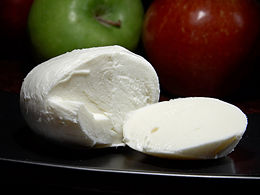Mozzarella
| Mozzarella | |
 |
|
| Country of origin | Italy |
|---|---|
| Region, town | Campania and elsewhere |
| Source of milk | Cow or water buffalo |
| Pasteurised | Sometimes |
| Texture | Semi-soft |
| Aging time | None |
| Certification | Mozzarella di Bufala Campana STG and DOP 1996[1] |
Mozzarella is a generic term for several kinds of originally Italian cheeses that are made using spinning and then cutting (hence the name; the Italian verb mozzare means "to cut"):
- Mozzarella di Bufala (buffalo mozzarella), made from domesticated water buffalo milk
- mozzarella fior di latte, made from fresh pasteurized or unpasteurized cow's milk
- low-moisture mozzarella, which is made from whole or part skim milk, and widely used in the foodservice industry
- smoked mozzarella
Fresh mozzarella is generally white, but may vary seasonally to slightly yellow depending on the animal's diet.[2] It is a semi-soft cheese. Due to its high moisture content, it is traditionally served the day it is made[3], but can be kept in brine for up to a week[4], or longer when sold in vacuum-sealed packages. Low-moisture mozzarella can keep refrigerated for up to a month[5], though some pre-shredded low-moisture mozzerella is sold with a shelf life of up to 6 months.[6] Mozzarella of several kinds are also used for most types of pizza, lasagna, or served with sliced tomatoes and basil in Insalata caprese.
Contents |
Types
The mozzarella from bufala campana (DOP 1996) is a particular type of mozzarella; some consider it the best for flavour or quality and it is protected by European DOP. It is a raw material in Italian style neapolitan Pizza - rather than mozzarella made with pasteurized cow's milk.
Mozzarella is available fresh; it is usually rolled in the shape of a ball of 80 to 100 grams (6 cm diameter), sometimes up to 1 kilogram (about 12 cm diameter), and soaked in salt water or whey, sometimes with added citric acid, until sold.
Fior di latte (written also as fiordilatte) is used to distinguish the mozzarella made from cow's milk from that made from buffalo's milk.
When slightly desiccated (partially dried), the structure becomes more compact; then it is better used to prepare dishes cooked in the oven, for example lasagne.
When twisted to form a plait it is called treccia.
It is also available in smoked (called affumicata) and reduced-moisture packaged varieties.
There are now offered a number of variations, such as "stuffed mozzarella", filled with olives and cooked or raw ham, as well as small tomatoes (pomodorini).
Production
The production of mozzarella involves the mixture of curd with heated whey, followed by stretching and kneading to produce a delicate consistency -- this process is generally known as pasta filata. According to the Mozzarella di Bufala trade association, "The cheesemaker kneads it with his hands, like a baker making bread, until he obtains a smooth, shiny paste, a strand of which he pulls out and lops off, forming the individual mozzarella." [7] It is then typically formed into ball shapes or in plait. In Italy, a "rubbery" consistency is generally considered not satisfactory; the cheese is expected to be softer.
Etymology
It has been said that the name "mozzarella", which is clearly derived from southern Italian dialects, was the diminutive form of mozza (cut), or mozzare (to cut off) derived from the method of working. Other theories describe its origins as a minor preparation of "scamozza" (Scamorza cheese), which in its turn probably derives from "scamozzata" ("without a shirt"), with allusion to the fact that these cheeses have no hard surface covering typical of a dry cured cheese.
The term mozzarella is first found definitively mentioned in 1570, cited in a cookbook by Bartolomeo Scappi, reading "…milk cream, fresh butter, ricotta cheese, fresh mozzarella and milk…"
An earlier reference is also often cited as describing mozzarella. Historian Monsignor Alicandri, in "Chiesa Metropolitana di Capua", states that in the 12th century the Monastery of Saint Lorenzo, in Capua, offered pilgrims a piece of bread with mozza or provatura. These are locations rather than products and mozza is taken by some to be mozzarella.
Nutritional data
Amount of nutrients in 100 g of edible portion of mozzarella, whole cow's milk or water buffalo milk:
| Energy | 1250 kJ / 300 kcal |
| Protein | 22 g |
| Fats | 22 g |
| Carbohydrates | 2.2 g |
| Total sugars | 1.0 g |
| Calcium, Ca | 500 mg |
| Phosphorus, P | 350 mg |
| Potassium, K | 76 mg |
| Sodium, Na | 630 mg |
See also
- Mozzarella sticks
- Mozzarella di Bufala Campana
- Scamorza cheese
- Pizza cheese
- String cheese
References
- ↑ Ministero delle politiche agricole alimentari e forestali | Banca Dati Prodotti DOP, IGP e STG
- ↑ "Mozzarella Cheese". www.sallys-place.com. Retrieved on 2008-04-01.
- ↑ "The Wine News Magazine - Burrata mozzarella's creamy cousin makes a fresh impression". www.thewinenews.com. Retrieved on 2008-04-01.
- ↑ "PCC Natural Markets : Healthnotes : Mozzarella". www.pccnaturalmarkets.com. Retrieved on 2008-04-01.
- ↑ "9 - Pizza Cheese -- Pizzeria Operations -- CorrellConcepts.com". www.correllconcepts.com. Retrieved on 2008-04-01.
- ↑ "Organic Valley - Shreds - Mozzarella, Low Moisture, Part Skim, Shredded, 6 oz.". www.organicvalley.coop. Retrieved on 2008-04-01.
- ↑ "Mozzarella di Bufala Campana trade organization". Retrieved on 2007-05-08.
External links
- A Step by Step Guide to Making Your Own Mozzarella Cheese
- Mozzarella di Bufala Campana trade organization
- The official DOP Consortium site - (Requires Flash)
|
|||||